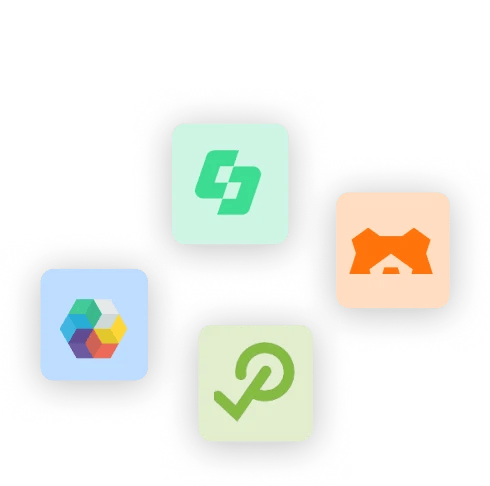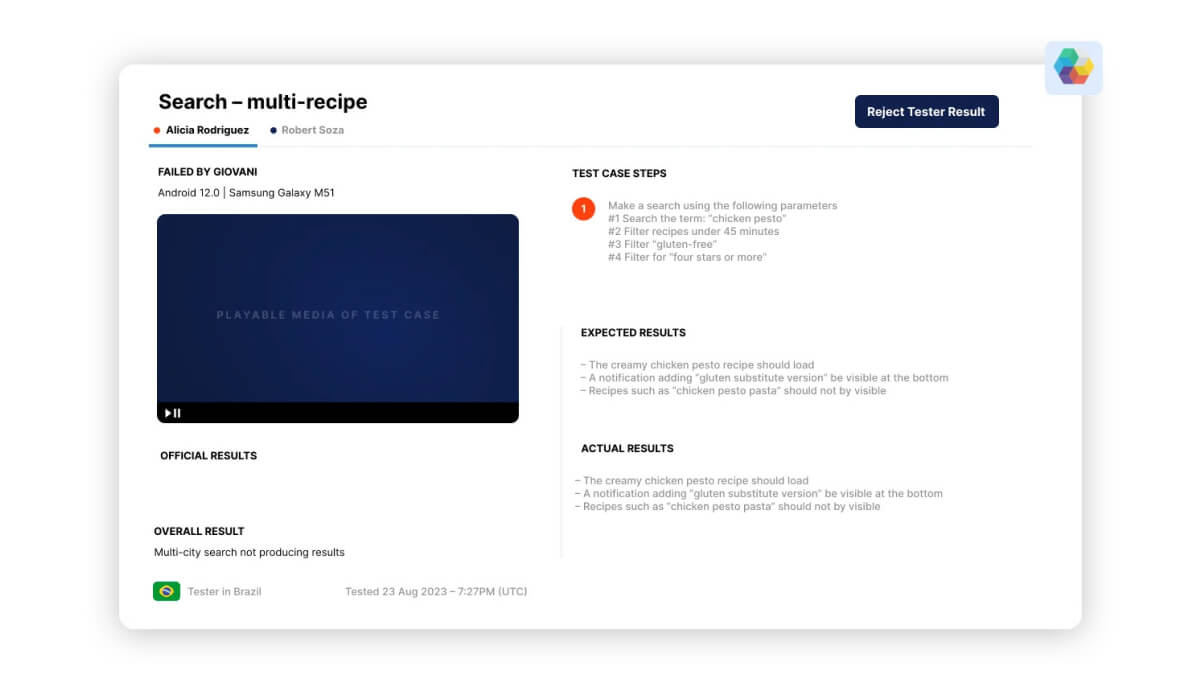-
How we help
- Does my software work?
- Does it work for all users?
- Global Growth Toolbox
- Industries
-
Platform
- Platform
- Integrations
- Browse all test types
- Add-on services
- Pricing
- Resources
Test.io alternatives to consider in 2025
Are you seeking Test.io alternatives? If you’re considering Test.io and you’re looking for a shortlist of suppliers to compare with, look no further.

Global App Testing vs Test.io vs others
Which business is better for your organization is likely to depend on your specific requirements. Set up a meeting with Global App Testing now and we can help you think about your provider.
- See Global App Testing vs Test.io
- Discuss other leading suppliers
- Understand which supplier is the right fit
- Talk in detail about your requirements
In this post, we highlight the top 5 solutions known for their strong testing capabilities and seamless integration with CI/CD workflows. We look at crucial tools that can help you progress your QA practices, with a focus on test management and performance testing. Find below our supplier shortlist of Test.io alternatives that might improve your software testing strategy to meet the unique requirements of your project:
1. Global App Testing
2. Zeuz
3. Leapwork
4. Bozzang
5. TestingWhizz

1. Global App Testing – "Best in class functional and UX testing"

We can’t lie – if you’re looking for other businesses to build a supplier shortlist for test.io, we’d love to be considered.
Global App Testing offers on-demand testing to help businesses ensure their applications perform flawlessly across various devices and operating systems, and that's suitable for different markets. We provide an efficient way to conduct real-world testing on a global scale, with a network of professional testers to uncover bugs and usability issues that might not be detected in a lab environment.
Get started with Global App Testing
Our approach combines the scalability of crowdsourced testing with detailed analytics, robust integration capabilities, and a comprehensive testing suite. All of it makes it an invaluable tool for businesses aiming to launch high-quality web or mobile applications that meet the demands of diverse, global user bases.
How Global App Testing works
The testing process is easy to manage from start to finish in a few simple steps:
- Clients outline specific tasks or scenarios they need to be tested, which are then distributed to testers matching the project's criteria.
- A global network of more than 90,000 vetted, professional testers execute tests on applications under real-world conditions.
- As testing progresses, clients receive real-time feedback and reports through the platform, enabling quick identification and resolution of issues.
- Each bug report or feedback item is validated for accuracy and relevance, ensuring clients receive only actionable data.

Key features
1. Wide tester network- Testers in over 190 countries, ensuring applications are tested in diverse environments and use cases.
- Tests are conducted across a broad spectrum of devices, OS versions, and network conditions, mimicking real user environments.
- Functional Testing: Verifies that every aspect of the app works as expected across different scenarios and conditions.
- Usability Testing: Provides insights into the user experience, highlighting areas for improvement to enhance app intuitiveness and engagement.
- Localization Testing: Ensures the app functions correctly in various locales, checking for cultural appropriateness and local language accuracy.
- Users can initiate tests and obtain results through multiple methods, including user interface interactions, integrations, or directly via API. GAT supports a range of integrations with popular development and testing tools like Jira, GitHub, TestRail, and Smartbear Zephyr, allowing for real-time launching and receiving of test results within users' existing workflows.
- A user-friendly dashboard presents real-time testing results, analytics, and insights, allowing immediate action on identified issues.
- Supports integration with existing bug tracking and project management tools, streamlining the bug resolution process.
2. Zeuz - "AI-powered, no-code automation for comprehensive testing."

ZeuZ is an automation platform that offers testing across web, mobile, desktop, and API. With its AI-driven, no-code approach, it claims to streamline test case creation, deployment, and management. Their services offer a white-glove, affordable solution that includes implementation, training, customizations, integrations, and support for a full-fledged test automation solution.
How does it work?
Zeuz enables users to create tests without coding, covering over 350 actions easily. ZeuZ supports various testing types and integrates seamlessly with existing tech stacks, offering both on-premise and SaaS options.
Key features according to their website:
1. Project management tools- Zeuz features a Kanban board for tracking milestones, progress, test executions, resolution times, and quality, enhancing project oversight for managers.
- Triggered emails and notifications keep teams informed about test outcomes and issues, ensuring prompt attention to failures.
- Benchmark testing, reusable templates, and screen capture capabilities streamline the testing process and enhance productivity.
- Access to reports and tools for image comparison, root cause analysis, specific data search, and automated rules creation for cross-channel testing processes.
- A variety of tests, including sanity, regression, stress and load, end-to-end, and security testing, cater to a broad spectrum of testing requirements.
- Facilitates easy integration with numerous third-party systems like Slack, Hira, Asana, Ansible, etc., enhancing workflow and communication.
3. Leapwork - "No-code automation for every application type."

Leapwork offers a no-code platform for automating tests across web, desktop, mobile, and virtual applications. They claim to emphasize simplicity, power, and efficiency in test automation.
How does it work?
Leapwork uses a visual language for test automation, making it accessible without coding expertise. It includes features for reusable components, hypervisual debugging, and cross-technology automation, integrating seamlessly with CI/CD tools.
Key features according to their website
1. Quality Assurance management- It offers to streamline your entire QA process, from planning and documentation to execution and reporting, while enhancing collaboration with software development teams.
- Easy automation of functional UI tests with a smart recorder that allows for simple capture and definition of UI elements, transforming test cases into flows.
- Improved efficiency by turning common testing steps into reusable sub-flows, reducing maintenance and development bottlenecks.
- Quick diagnoses of test failures using a trio of tools: video recordings, data-level insights, and activity logs, to understand both the 'what' and the 'why' behind issues.
- Conducting tests across browsers and devices via Cloud providers, local machines, or remote computers.
- Enhanced testing efficiency by integrating with any CI/CD tool, allowing for earlier testing and faster feedback loops.
4. Boozang - "Build. Test. Automate."

Boozang offers a no-code solution for front-end testing, tailored for today's web and exclusively using Javascript. This tool enables both developers and Quality Assurance engineers to swiftly create front-end tests without relying on traditional programming skills.
How does it work?
Diverging from Selenium-based frameworks, Boozang overcomes the common constraints associated with Selenium and its WebDriver. It introduces a unique selection language grounded in natural language processing, facilitating native support for both Test-Driven Development (TDD) and Behavior-Driven Development (BDD). Furthermore, Boozang enhances testing efficiency by supporting automatic test generation from predefined models, promoting a model-based testing approach.
Key features according to their website
1. Comprehensive integration capabilities- Compatibility with a wide range of popular development and testing tools for a cohesive workflow.
- Boozang offers a singular solution for conducting both UI and API tests, complete with a unified reporting dashboard. This facilitates efficient management and monitoring of testing activities while also supporting the generation of data-driven API tests from UI tests to enhance productivity.
- Utilizing NLP for selectors, Boozang ensures tests are robust against UI changes by focusing on visible page elements. Features like instant test repair through element re-selection save time and reduce effort.
- With built-in support for Cucumber and compatibility with tools like Xray and JIRA, Boozang encourages using Gherkin for business logic-driven testing. This integration promotes better collaboration between testers and stakeholders, ensuring tests meet business objectives.
- This feature helps identify and address the fundamental reasons behind test failures. This approach helps improve testing effectiveness by prioritizing issues impacting business outcomes.
- The simplified application testing process utilizing HTML canvas makes recording and validating complex actions such as drag & drop easier. This capability is particularly beneficial for testing applications with significant canvas element use, ensuring thorough test coverage.
5. TestingWhizz - "A codeless test automation tool."

TestingWhiz is a codeless test automation tool designed for a wide range of testing scenarios within a single test case, including web, database, regression, and mobile testing. It features a Selenium import function for easy migration of existing tests, a job scheduler, record & playback capabilities, AI-driven web application recording, integrated mobile recording, and cross-browser testing.
How does it work?
TestingWhiz operates based on a codeless automation framework, simplifying the test automation process and making it accessible for testers of varying skill levels, including those with little to no coding expertise.
Key features according to their website
1. Selenium import- Easy migration of the existing Selenium tests into TestingWhiz without the need to rewrite them, thanks to the built-in Selenium Java editor.
- Advanced scheduling capabilities allow setting test executions at specific dates and times, including frequency adjustments, with the option to email reports post-execution.
- A straightforward approach to creating test cases through recording actions performed on web applications and playing them back to compare actual results against expected outcomes.
- Data integrity checks through database comparisons and comparison of data and images in PDF files.
- Supports test execution on multiple computers via a shared network and provides Kubernetes/Docker support for easy management of test environments.
- Features that speed up the automation process and leverage AI and machine learning for smarter testing solutions.
How to choose the best tool for your needs?
Selecting the best software testing tools and frameworks involves a structured approach:
1. Identify testing objectives: Understand what you aim to achieve with testing – functionality, performance, security, etc. – and whether you'll automate or manually test.
2. Assess the testing environment: Ensure tools are compatible with your hardware, software, and user scenarios.
3. Evaluate tool features: Compare tools against your needs for ease of use, flexibility, support types, analytics, cost, and community support.
4. Gather peer insights: Seek advice from experienced testers and consult testing communities for recommendations.
5. Trial and refine: Test tools in real scenarios, monitor performance, and be ready to adjust as your project evolves.
This phased approach helps systematically narrow choices to find tools that best fit your specific testing requirements and environment.
What makes Global App Testing different?
Although there is no "one size fits all" when choosing the right tool and Test.io alternative, we must be biased.
If you choose to put Global App Testing on your alternatives shortlist, here are the benefits to expect:
- One of our primary benefits is the ability to quickly scale testing efforts to meet urgent deadlines. Traditional testing services, particularly those relying on in-house teams, often face constraints in scaling up rapidly due to resource limitations. GAT's crowd-sourced model allows for a large number of tests to be conducted simultaneously across different environments, leading to faster test completion times.
- Our flexible testing efforts can be scaled up or down based on the project's needs without long-term commitments or significant upfront investments.
- The agility of our approach enables quicker feedback loops, allowing development teams to receive and act on test results promptly.
So, if you want to learn more about our solutions, let's schedule a call today!
Keep learning
7 beta testing tools to consider
6 QA testing methodologies and techniques
10 types of QA testing you need to know about
